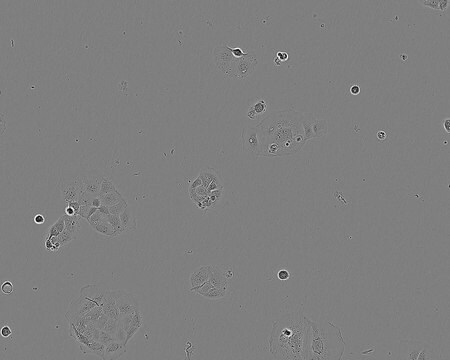RAW 264 Cell Line from mouse
NOTE: Both the cell line and DNA from the cell line may be available for this product. Please choose -1VL or VIAL for cells, or -DNA-5UG for DNA, 85062803, mouse blood, Macrophage
Autenticatiper visualizzare i prezzi riservati alla tua organizzazione & contrattuali
About This Item
Codice UNSPSC:
41106514
Prodotti consigliati
Origine biologica
mouse blood
Descrizione
Mouse leukemic monocyte-macrophage
Confezionamento
tube of 5 μg 85062803-DNA-5UG
pkg of vial of cells 85062803-1VL
Modalità di accrescimento
Semi-adherent
Cariotipo
Not specified
Morfologia
Macrophage
Prodotti
Lysozyme
Recettori
Immunoglobulin and complement
tecniche
cell culture | mammalian: suitable
Malattie correlate
cancer
Condizioni di spedizione
dry ice
Temperatura di conservazione
−196°C
Origine della linea cellulare
Mouse leukaemic monocyte-macrophage
Descrizione della linea cellulare
Established from an ascites of a tumour induced in a male mouse by intraperitoneal injection of Abselon Leukaemia virus (A-MuLV). Cells with pinocytose neutral red and phagocytose zymosan. Cells capable of antibody-dependent lysis of sheep erythrocytes and tumour targets. Growth inhibited by LPS (0.5ng/ml).
Applicazioni
RAW 264 Cell Line from mouse has been used:
- to study the anti-inflammatory effect of galectin-3 on RAW 264 macrophages which are stimulated with lipopolysaccharide
- to study the effect of titanium particles on progranulin (PGRN) expression in RAW 264 cells
- to study the effects of a nutritional supplement on interferon-γ (IFN-γ)-induced expression of macrophage chemoattractant protein-1 (MCP-1) and intercellular adhesion molecule-1 (ICAM-1)
Terreno di coltura
EMEM (EBSS) + 2mM Glutamine + 1% Non Essential Amino Acids (NEAA) + 10% Foetal Bovine Serum (FBS) or DMEM + 2mM Glutamine + 10% Foetal Bovine Serum (FBS).
Mantenimento delle subcolture
Split sub-confluent cultures (70-80%) 1:3 to 1:6 i.e. seeding at 2-4x10,000 cells/cm2; 5% CO2; 37°C. Remove the cells mechanically. Cells are semi-adherent, i.e. some cells grows in suspension, some loosely attach to the surface and others flattened out and attach to the flask. Cells should not be allowed to overgrow and become confluent as this can lead to loss of the flattened adherent cell characteristic.
Altre note
Additional freight & handling charges may be applicable for Asia-Pacific shipments. Please check with your local Customer Service representative for more information.
Scegli una delle versioni più recenti:
Certificati d'analisi (COA)
Lot/Batch Number
It looks like we've run into a problem, but you can still download Certificates of Analysis from our Documenti section.
Se ti serve aiuto, non esitare a contattarci Servizio Clienti
Possiedi già questo prodotto?
I documenti relativi ai prodotti acquistati recentemente sono disponibili nell’Archivio dei documenti.
Il team dei nostri ricercatori vanta grande esperienza in tutte le aree della ricerca quali Life Science, scienza dei materiali, sintesi chimica, cromatografia, discipline analitiche, ecc..
Contatta l'Assistenza Tecnica.



